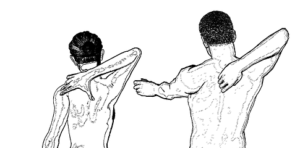 Scapular winging is a sign of muscular dysfunction of the muscles around the shoulder blade resulting in the base of the shoulder blade protruding from your back in an abnormal position. This winging of the shoulder blade occurs when any of the three muscles that stabilize the shoulder blade are not working in. This leads to a break in the rhythmic motion of the scapula and can affect a person’s ability to lift, pull and push weighty objects. In some serious cases the ability to perform daily tasks such as dressing yourself or washing your hair may be hindered. This asynchronisation is present in many other shoulder conditions such as impingement syndromes, rotator cuff injury, labral injury and instability of the shoulder. The painful symptoms that you feel in your shoulder are due to a disruption of the centering of the arm bone in your shoulder socket. Scapular winging may also be caused by injury to the nerves that supply the scapular stabiliser muscles. These three muscles are: serratus anterior, trapezius and the rhomboids. Serratus anterior is the most commonly affected muscle.
Scapular winging is a sign of muscular dysfunction of the muscles around the shoulder blade resulting in the base of the shoulder blade protruding from your back in an abnormal position. This winging of the shoulder blade occurs when any of the three muscles that stabilize the shoulder blade are not working in. This leads to a break in the rhythmic motion of the scapula and can affect a person’s ability to lift, pull and push weighty objects. In some serious cases the ability to perform daily tasks such as dressing yourself or washing your hair may be hindered. This asynchronisation is present in many other shoulder conditions such as impingement syndromes, rotator cuff injury, labral injury and instability of the shoulder. The painful symptoms that you feel in your shoulder are due to a disruption of the centering of the arm bone in your shoulder socket. Scapular winging may also be caused by injury to the nerves that supply the scapular stabiliser muscles. These three muscles are: serratus anterior, trapezius and the rhomboids. Serratus anterior is the most commonly affected muscle.
Scapular winging occurs when the serratus anterior muscle does not contract at the correct time during movements. Your brain may not be sending the signals to activate your muscle at the correct time, and it may not be until you perform loaded overhead movements that your symptoms begin to show. This dysfunction of the serratus anterior causes the edge of the scapular closest to your spine to come off the rib cage and protrude off your back (wing). You may have had this problem for a while but it has never been an issue until you have increased your workload on the joint.
Examples:
- If you have increased your workout load at the gym from 2 sessions a week to 6
- If you have decided to take up swimming because your knees have given up
- If you suddenly have to carry your children around all day
All of these activities put increased load on the shoulder and if your muscles are not working in perfect sync together you will have symptoms of pain, clicking, aching or tight tired muscles.
Physiotherapy treatment for this shoulder pain and scapular winging is conservative using a combination of pain relief, manual therapies and strength/stability exercises. If conservative treatment does not work then other measures can be taken.
To combat the secondary symptoms of serratus anterior dysfunction you must be able to activate and coordinate the serratus anterior muscle with the other shoulder stabilizers with a range of activities. Rehabilitation time varies depending on the individuals’ compliance with their rehabilitation program and body awareness. You will see reduced symptoms as the muscle contracts more and becomes stronger, however to regain full function it can take up to 12 weeks.
If you are experiencing shoulder pain or think your scapular is winging” come and see your Sydney Sports Physio at Bend + Mend. We are experienced in treating all types of shoulder pain and will provide you with a clear diagnosis and treatment for your return to full pain-free function.





